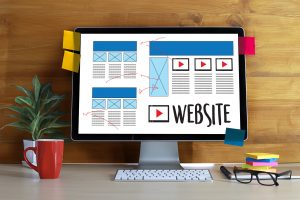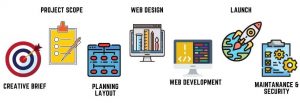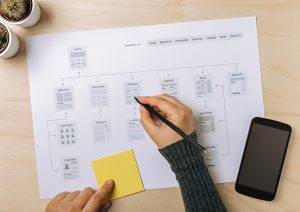7 Steps to Create a Professional Website
What to Expect When Working with Web Design Company

“Getting a quality website is not an Expense but an Investment…” Dr. Chris Dayagdag
Where to start?
If you just opened a business and looking to create a website for it, or your old site desperately needs updates as it is no longer properly representing you online. If you are looking to establish online presence, improve awareness, increase traffic and leads coming from search engines, in this case you need a well-designed and effective website. But where to get one? Should you create a site yourself on one of the website builder platforms, like WIX.com, Squarespace.com, GoDaddy.com? Perhaps, hire a professional company that has established web design process & will perform this task for you, see our packages here.
Doing it Yourself
When doing it yourself on one of the drag & drop sites mentioned above, worth to note, it is far not as easy as it is described in commercials, but definitely doable. You would need to educate yourself on how the website builder works. There are plenty of free tutorials available on Youtube.com plus each DIY website building platform offers their own training when you first sign up. It would take you anywhere from few days to few weeks depending on the size and complexity of the project. You won’t be able to customize it around your brand 100% as all those web constructors use generic templates, nevertheless you can still create a working website, with your company information, logo, pictures, products, any other brand elements you have available.
Also, you should be able to connect this site to your personal domain (domain: vpwebsolution.com) and your company’s business email (vp@vpwebsolutions.com). Overall, much better option than no website at all, especially if you have limited or no digital marketing budget to spend. But keep in mind, professional and well-designed website is an investment not an expense, therefore good site will pay itself off within a couple of months by increasing your traffic, leads and sales.
 Hire Professionals
Hire Professionals
In case if you do have digital marketing budget to spend and ready to take your business to the next level with professional and functional website, we recommend hiring professional web design company to carry out this project for you. Good agency will have a web design process in place to craft a website around your brand, product and your customer’s needs. They will be able to come up with unique web design solutions to make your site intuitive, attractive, responsive (mobile friendly), fast and most importantly search engine optimized.
In this Blog we would like to go over website development stages, their timelines and steps needed to complete a professional site that will promote your brand awareness, leads and increase sales. Well-designed and functional website takes on average 12-14 weeks to complete, and consists of several stages.
7 Steps of Website Building
At VP Web Solutions, we recognize 7 steps of website creation process, where each of them takes between 1 to 3 weeks to complete. Seventh step Maintenance & Security is more of an after-delivery service, but it is a vital part of your site’s success, therefore this step cannot overlooked.
-
- Creative Brief
- Project scope
- Planning Layout
- Web Design Process
- Web Development
- Launch
- Maintenance & Security

Now, after we outlined the process, lets dig in deeper into each step and what it entails.
1. Identifying Goals
This step is hard to overestimate, as clearly identified goal will make it much easier to design a site that will properly represent your business on the web. On this stage you should expect to answer serious of goal identifying questions:
- What is a goal of the website?
- Who is your primary audience? Who is this site for?
- Where are your competitors? What are their websites?
- What is unique about your product/service/brand?
- How about your expectations of the website?
- What brand attributes do you already have? (logo, domain, colors, etc)
After we receive your initial questionnaire back, our web design team lead will go over your answers, target audience and competitors’ sites. He will analyze your niche and competition, their websites, branding, keywords to determine most effective techniques to design your site. All the information will be inserted into creative brief and send back for your approval.
2. Project Scope
Next step includes determining and documenting a list of specific deliverables, site features, functions, timeline and costs. In other words, the amount of work required to create your site, number of pages, sitemap and structure, desired features (interactive contact form, shopping cart, online payments, videos, sliders, etc) it also includes approved creative brief and timeline for the website to be complete. In addition, during this step project costs are negotiated and finalized.
Once we received clear understanding of your business and your new website’s goals and requirements, we will go over web design process timeline and cost of the project. Everything will be agreed and finalized in Web Design contract (inclusive of all elements listed above), then we will start on your website design.

3. Planning Layout
This is a stage of website development process when based on creative brief and project scope we determine your site structure, number of pages, their linking and relationships, as well as creating a wireframe for every page of your future site. Once that is done, we send sitemap and wireframe for your review and approval.
Let’s look into each part of this process in detail:

-
- Sitemap, is when we create a sitemap with page hierarchy, that provides a foundation for any well designed and functional website. Sitemap gives an overall idea of content architecture and clarifies the relationship between content elements and various pages of the site.
- Page Layouts. After sitemap is done, it is time to outline the lay out for every single page of your future website. Firstly, time to plan your site visitors’ journey through its pages and how they will interact and access your content. Secondly, how will they move through information and visuals you provided and complete desired action. For instance: make a purchase, send an inquiry, subscribe to your mail list, etc, which is an ultimate goal of your site.
- Build website Wireframe. Once you have created a sitemap and established page layouts, it is time to build the wireframe and mockup of your site, which will serve as visual guide for design and development team.
4.Web Design Process
This is a start of the actual website building process, when your site is virtually taking its shape and form its identity. During this step, we select following elements for your site:
-
-
- Colors scheme
- Fonts and text sizes
- Artwork & Graphics
- Visual elements (buttons, menu boxes, transitions)
- Special effects (shades, frames, fade)
-
Our web design team also insures they are creating best possible experience for your site visitors, creating “site flow” as they answer following questions:
-
-
- Is site intuitive? How easy is to navigate it?
- How hard is to find different items throughout the site pages?
- What about transitions between the pages? From packages to prices, to contact info?
- Is your call to action clear and visible on all landing pages?
- What about mobile friendliness? Is your website equally effective on smartphone as it is on desktop?
-
We build websites using Responsive Web Design (mobile friendly) which is an approach to website building that uses flexible layouts, flexible images and cascading style sheet media queries. Main purpose of responsive web design is to create pages that identify user’s device, screen size and orientation in order to change your website’s layout accordingly.

Responsive web design creates dynamic changes to the appearance of a website, depending on the screen size and orientation of the device being used to view it. Responsive Design is one approach to the problem of designing for the multitude of devices available to customers, from small smartphones to large desktop monitors” (nngroup.com).
During web design stage we also incorporate your Brand elements, such as logo, colors, images, fonts, videos or any other Business attributes you might have. Once all those aspects of web design are settled, it is time to start web development.
5. Web Development
Or simply coding is the next step when web developers start putting together all the elements and features mentioned above and create the backbone and frame of your website online by performing following tasks:
-
-
- Ensuring accessibility & web standards are followed
- Selecting appropriate framework, we prefer Content Management System (CMS)
- Configuring database of your site
- Integrating Clients Content (information, titles, descriptions, articles, videos)
- Optimizing site performance (website loading speed)
- Developing site security protocol (protecting personal information)
- Adding Schema Markup to all site pages to improve its SEO (schema.org)
- Checking website functionality
-
Clients provide all the site content (pictures, articles, blogs, product descriptions, videos). We recommend all our clients to start working on their site content as soon as we sign the contract. As this is something that will take time, especially if you are building site from scratch. It might require you writing several articles, filming “about company” video, having your team photoshoot scheduled, taking professional pictures of your products, etc. One cannot simply copy paste information or images from the web, as it would violate copyright law. In addition, Google would also blacklist your site, as its algorithm is trained to pick up copy-paste schemes, so your site could potentially be excluded from its search results. Therefore, your website’s content needs to be authentic.
Once client provides all content needed to fill up a website, our team will integrate it on the pages and ensure it flows well with the rest of design elements providing interactive user experience.
6. Launch
This is a final stage of the web design process; last push and your custom-made website is live. Take a closer look on what happens at this stage, to ensure thorough testing, smooth launch and amazing user experience:
- Final testing of all buttons, functions, all deliverables mentioned in creative brief
- Transferring site to client’s domain and server, going live
- Quality Assurance, asking client and their employees to navigate site and check for any mistakes or misspells or broken links. Checking if contact form is going to right mailbox or the quick access buttons are working the way they should.
- Connecting new site to Google Analytics for client to be see main website statistics, traffic, leads, most popular pages, visitors’ demographics, etc
- Connecting site to Google Search Console, in order for Google to crawl your new site. Submitting your sitemap to Google Search console, to ensure it is indexed and recognized by Google to appear in search results.
- Personalizing site image & login experience
- Creating Admin Panel for client, to be able to login and navigate back-end of the website. Client should able to do basic changes on the website (adding pictures, writing blogs, checking analytics)
- Creating WordPress Username and Login for client to be able to access Admin Panel and navigate the back-end
- Basic training on how to use Admin Panel to be able to perform site updates, add blog posts, images, etc
7. Maintenance & Security
As it states in our favorite quote, – “Your Website is not an expense it is an Investment” by Dr. Chris Dayagdag. Think about it, your website is the largest digital marketing asset you will ever have. So it makes total sense to take a good care of it and keep it in best running condition. Similar to oil changes on your car, just a bit more complex…
Just imagine, you are launching your brand new and shiny website, it thrills and excites your visitors. It is functional, intuitive, responsive, easy to use, and also brings you quality leads instantly increasing your sales by 25%. But as time goes by, you are finding out that you would like some page color adjustments. You need to change couple product names and update seasonal pictures on the home page slider.
It is very important to work on your website’s search engine optimization (SEO). In addition, you can track your site’s traffic and audience through Google Analytics. It will allow you to target potential customers with more precision and increase conversion rate through organic search results. So maybe that maintenance and security package was not that bad of idea. Maybe it would save you hours trying to figure it out on your own, plus who knows if your SEO updates actually improved and not harmed your site?
In addition, your site will also need basic plugin and security updates as digital marketing landscape is constantly evolving. Many web designers believe that website is never “completely finished”. In order for the website to generate maximum returns for your business it requires ongoing maintenance and optimization. Now, that you realized how important this step is, let’s take a look what this step typically includes.
Maintenance & Security Services
-
- Support & troubleshoot any errors and messages that occur to you or your visitors, to keep business running and customers happy
- Security tests & updates, plugin updates and add on installations
- HTTP & SSL Security Protocol Updates
- Performing A/B tests (user experience research methodology). To determine what changes and adjustments needed to maximize site’s effectiveness (click-through rate, conversions)
- Bad link clean up and ensuring all your web pages are properly indexed through Google search console
- Depending on the package this stage may also include design, functionality and content updates. Additional products, pages, blog posts, color changes, layouts, etc.
Conclusion
In conclusion, would like to highlight that website design & development takes on average anywhere between 2 to 3 months, and depends on number of pages and design complexity. Small sites are usually done in a few weeks period, but never overnight. In order to be an effective digital marketing tool, your website needs to go through all 7 stages explained above. We also recommend to keep open communication with web design agency. In addition, have all your images and content ready on time, it will speed up the process.
Roman K 1/15/21

 Hire Professionals
Hire Professionals